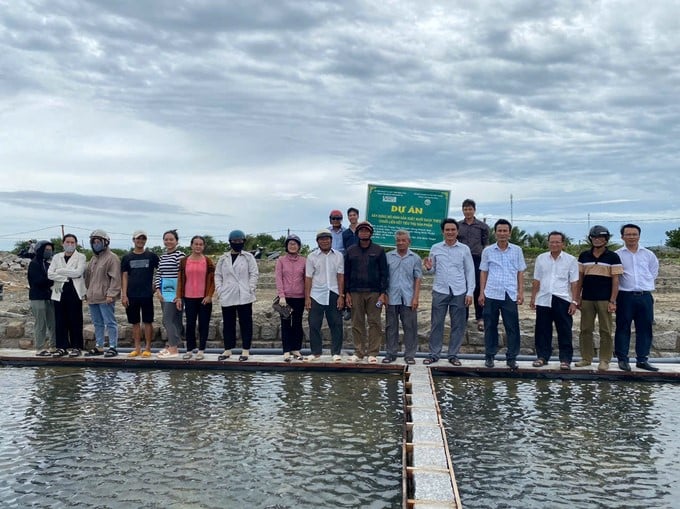November 28, 2025 | 05:36 GMT +7
November 28, 2025 | 05:36 GMT +7
Hotline: 0913.378.918
November 28, 2025 | 05:36 GMT +7
Hotline: 0913.378.918
In Nhon Hai commune (Ninh Hai district, Ninh Thuan province), the Ninh Thuan Agricultural Extension Center has just held a preliminary conference on the project "Building a model of clean salt production model in the chain of product consumption linkage," with the participation of more than 120 salt farmers and delegates from salt-producing communes in Ninh Hai district.
Ninh Thuan is a locality with a long-standing traditional salt-making profession with an area of 3,059 hectares and an average annual output of more than 450,000 tons. Salt production is concentrated mostly in Ninh Hai and Thuan Nam districts and linked to purchasing by companies and cooperatives.

Salt farmers visit the model of salt production on HDPE tarpaulin in Nhon Hai commune, Ninh Hai district.
Currently, in general, salt production areas of the province have not been planned or invested in infrastructure to serve production. Salt promotion models are few, single, and lacking in uniformity. In addition, salt-making households produce according to traditional manual methods with rudimentary and outdated technology, so the harvested salt products are mixed with many impurities and often experience the situation of "good harvest, bad price."
To help salt farmers apply scientific and technical advances to production and develop the salt industry in an effective and sustainable direction, in 2023, with the attention of the Ministry of Agriculture and Rural Development, the National Agricultural Extension Center and the Khanh Hoa Agricultural Extension Center coordinated with the Ninh Thuan Agricultural Extension Center to organize project implementation.
In 2024, the project was implemented with a scale of 1 ha/household (covering HDPE tarpaulin for 1,200 m2 of crystallization cells and 245 m2 of seawater reservoir) in Nhon Hai commune, Ninh Hai district. As a result, the expected yield is expected to reach an average of 177 tons/ha/year, 45% higher than the land-based production method, and the selling price is 22% higher. Economic efficiency increases by 24% compared to households producing outside the model.
Salt grain crystallization time is reduced, helping to shorten the production cycle, save time and labor, minimize environmental pollution, and limit product loss. Salt grains are firm, large, clear white, with few impurities. Households implementing the project can sign a contract with the cooperative to purchase 60% or more of the salt output in the model during the implementation period (about 150 tons) without worrying about price squeezes from traders.
Attending the conference, delegates visited the project's salt field covered with HDPE tarpaulin and listened to shared experiences from households directly implementing the project. Most farmers hope that in the coming time, levels and local governments will pay attention and create more capital conditions for them to boldly invest in technical advances in salt production. Thereby contributing to converting from traditional, outdated salt production methods to salt production methods using clean salt technology.
Translated by Thu Huyen

(VAN) According to Mr. Vo Minh Thanh, Director of the Tay Ninh Department of Agriculture and Environment, Resolution 57 has created a new development pathway for the locality, shifting from traditional toward modern agriculture.
/2025/11/26/4909-2-154329_878.jpg)
(VAN) Pearl grouper farming in HDPE cages not only delivers economic efficiency but also contributes to protecting the environment, creating jobs, and promoting marine-based experiential tourism.

(VAN) The model of making a living under the forest canopy through the agroforestry system in Van Son commune, Bac Ninh province, is expected to generate an annual income of approximately VND 30 million/ha.

(VAN) Many enterprises in Can Tho are harnessing natural energy and reducing greenhouse gas emissions in their production processes, thereby contributing to the promotion of a sustainable green transition.
/2025/11/24/3536-2-112800_176.jpg)
(VAN) Dong Nai now has tens of thousands of hectares of forests certified for sustainable management, and this area will continue to be expanded in the coming period.

(VAN) Vinh Ha hamlet (Dai Xuyen commune, Hanoi) is shifting away from small-scale farming as households adopt bioscurity into their breeder chicken models.

(VAN) Heavy rains make aquatic species more vulnerable to disease. Proactive water management and high-tech systems help farmers prevent outbreaks and protect yields.